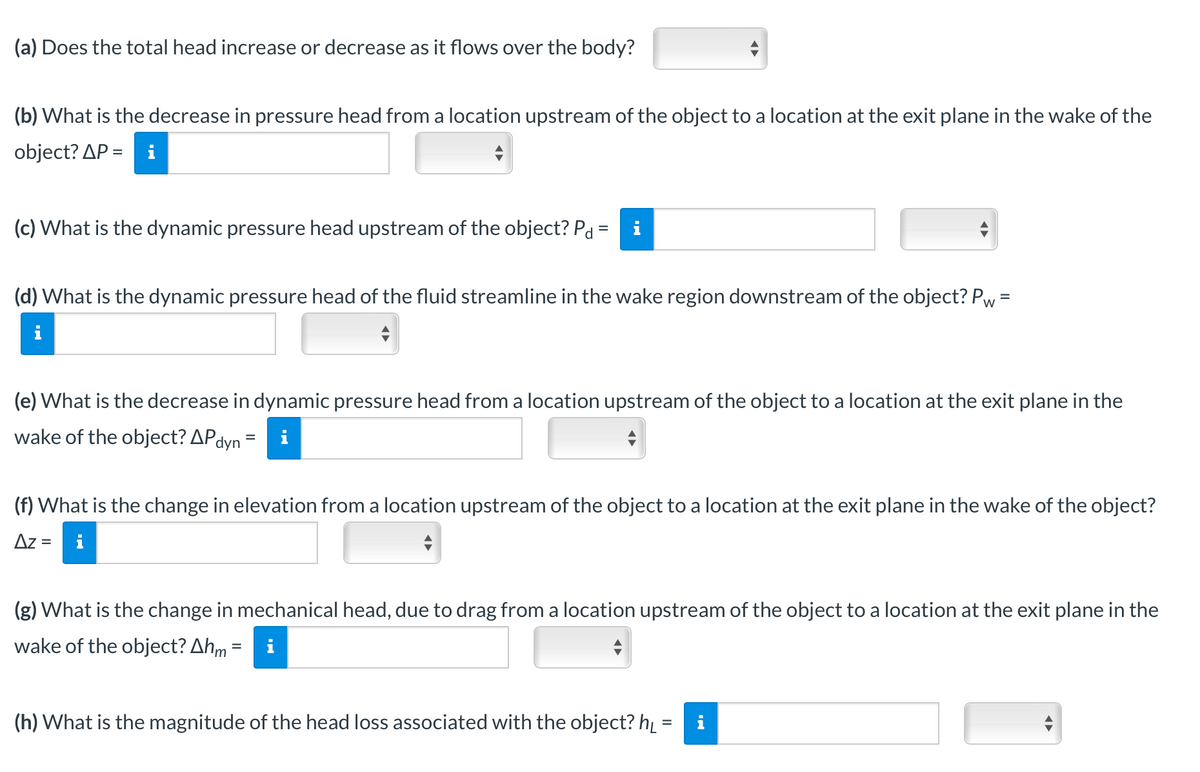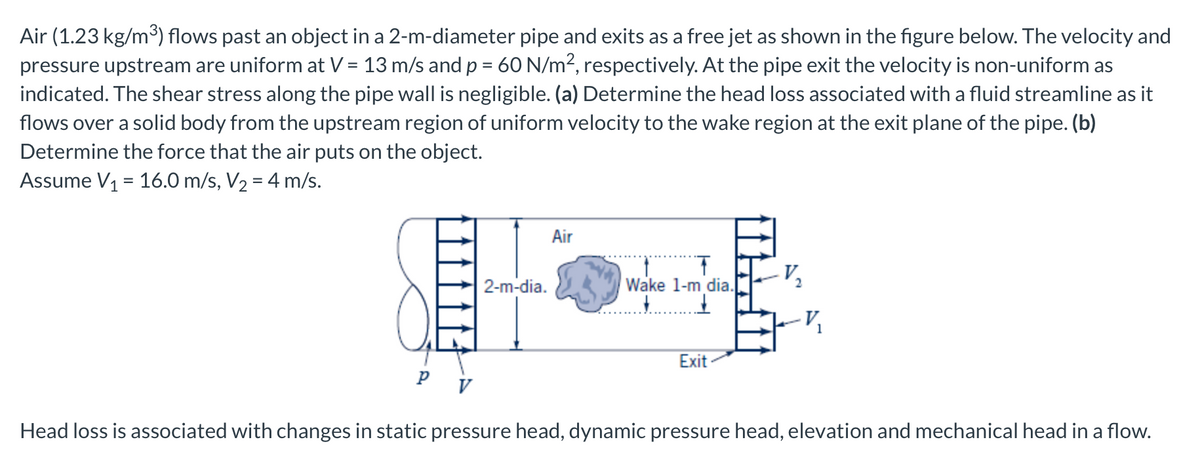(a) Does the total head increase or decrease as it flows over the body? (b) What is the decrease in pressure head from a location upstream of the object to a location at the exit plane in the wake of the object? AP = i (c) What is the dynamic pressure head upstream of the object? Pd= + (d) What is the dynamic pressure head of the fluid streamline in the wake region downstream of the object? Pw= i + + (e) What is the decrease in dynamic pressure head from a location upstream of the object to a location at the exit plane in the wake of the object? AP dyn = (f) What is the change in elevation from a location upstream of the object to a location at the exit plane in the wake of the object? Az = i (h) What is the magnitude of the head loss associated with the object? h = (g) What is the change in mechanical head, due to drag from a location upstream of the object to a location at the exit plane in the wake of the object? Ahm = i i
(a) Does the total head increase or decrease as it flows over the body? (b) What is the decrease in pressure head from a location upstream of the object to a location at the exit plane in the wake of the object? AP = i (c) What is the dynamic pressure head upstream of the object? Pd= + (d) What is the dynamic pressure head of the fluid streamline in the wake region downstream of the object? Pw= i + + (e) What is the decrease in dynamic pressure head from a location upstream of the object to a location at the exit plane in the wake of the object? AP dyn = (f) What is the change in elevation from a location upstream of the object to a location at the exit plane in the wake of the object? Az = i (h) What is the magnitude of the head loss associated with the object? h = (g) What is the change in mechanical head, due to drag from a location upstream of the object to a location at the exit plane in the wake of the object? Ahm = i i
Elements Of Electromagnetics
7th Edition
ISBN:9780190698614
Author:Sadiku, Matthew N. O.
Publisher:Sadiku, Matthew N. O.
ChapterMA: Math Assessment
Section: Chapter Questions
Problem 1.1MA
Related questions
Question

Transcribed Image Text:(a) Does the total head increase or decrease as it flows over the body?
(b) What is the decrease in pressure head from a location upstream of the object to a location at the exit plane in the wake of the
object? AP = i
(c) What is the dynamic pressure head upstream of the object? Pd = i
(d) What is the dynamic pressure head of the fluid streamline in the wake region downstream of the object? Pw=
=
(e) What is the decrease in dynamic pressure head from a location upstream of the object to a location at the exit plane in the
wake of the object? AP dyn
=
(f) What is the change in elevation from a location upstream of the object to a location at the exit plane in the wake of the object?
Az = i
(g) What is the change in mechanical head, due to drag from a location upstream of the object to a location at the exit plane in the
wake of the object? Ahm
(h) What is the magnitude of the head loss associated with the object? h₂ =
◄►

Transcribed Image Text:Air (1.23 kg/m³) flows past an object in a 2-m-diameter pipe and exits as a free jet as shown in the figure below. The velocity and
pressure upstream are uniform at V = 13 m/s and p = 60 N/m², respectively. At the pipe exit the velocity is non-uniform as
indicated. The shear stress along the pipe wall is negligible. (a) Determine the head loss associated with a fluid streamline as it
flows over a solid body from the upstream region of uniform velocity to the wake region at the exit plane of the pipe. (b)
Determine the force that the air puts on the object.
Assume V₁ = 16.0 m/s, V₂ = 4 m/s.
2-m-dia.
Air
Wake 1-m dia.
+
Exit
-V₂
-V₁₂₁
Head loss is associated with changes in static pressure head, dynamic pressure head, elevation and mechanical head in a flow.
Expert Solution
This question has been solved!
Explore an expertly crafted, step-by-step solution for a thorough understanding of key concepts.
This is a popular solution!
Trending now
This is a popular solution!
Step by step
Solved in 4 steps with 1 images

Knowledge Booster
Learn more about
Need a deep-dive on the concept behind this application? Look no further. Learn more about this topic, mechanical-engineering and related others by exploring similar questions and additional content below.Recommended textbooks for you

Elements Of Electromagnetics
Mechanical Engineering
ISBN:
9780190698614
Author:
Sadiku, Matthew N. O.
Publisher:
Oxford University Press

Mechanics of Materials (10th Edition)
Mechanical Engineering
ISBN:
9780134319650
Author:
Russell C. Hibbeler
Publisher:
PEARSON

Thermodynamics: An Engineering Approach
Mechanical Engineering
ISBN:
9781259822674
Author:
Yunus A. Cengel Dr., Michael A. Boles
Publisher:
McGraw-Hill Education

Elements Of Electromagnetics
Mechanical Engineering
ISBN:
9780190698614
Author:
Sadiku, Matthew N. O.
Publisher:
Oxford University Press

Mechanics of Materials (10th Edition)
Mechanical Engineering
ISBN:
9780134319650
Author:
Russell C. Hibbeler
Publisher:
PEARSON

Thermodynamics: An Engineering Approach
Mechanical Engineering
ISBN:
9781259822674
Author:
Yunus A. Cengel Dr., Michael A. Boles
Publisher:
McGraw-Hill Education

Control Systems Engineering
Mechanical Engineering
ISBN:
9781118170519
Author:
Norman S. Nise
Publisher:
WILEY

Mechanics of Materials (MindTap Course List)
Mechanical Engineering
ISBN:
9781337093347
Author:
Barry J. Goodno, James M. Gere
Publisher:
Cengage Learning

Engineering Mechanics: Statics
Mechanical Engineering
ISBN:
9781118807330
Author:
James L. Meriam, L. G. Kraige, J. N. Bolton
Publisher:
WILEY